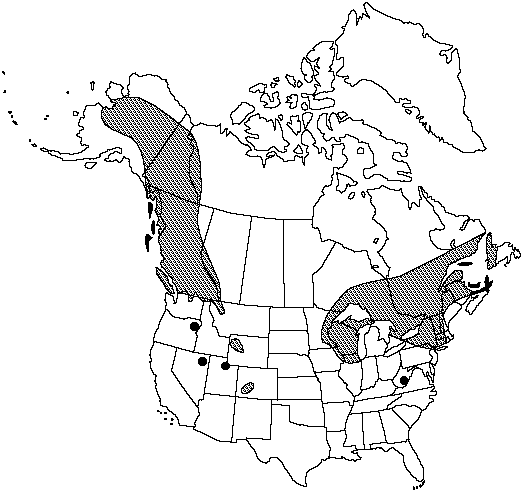Cryptogramma stelleri
in Engler,Bot. Jahrb. Syst. 3: 413. 1882.
Stems creeping, few branched, slender, 1–1.5 mm diam., succulent, brittle; scales colorless, sparse, transparent-reticulate, ovate, 0.4 × 0.3 mm; stems shriveling in 2d year following emergence of leaves. Leaves scattered along stems, ephemeral (dying by late summer), soon shed; sterile leaves erect, 3–15 cm; fertile leaves erect, 5–20 cm; petioles, costae, and costules glabrous. Petiole dark-brown in proximal 1/2 or less, becoming greenish distally, ca. 1 mm wide when dry, only slightly furrowed, glabrous. Blade broadly lanceolate to ovatelanceolate, all pinnate-pinnatifid to 2-pinnate, herbaceous to membranous, thin; hydathodes superficial, often poorly developed or absent. Segments of sterile leaves ovatelanceolate to fan-shaped, distal 1/2–1/3 shallowly lobed; segments of fertile leaves horizontal to ascending, often only partially differentiated from sterile leaves, lanceolate to linear, 8–25 × 2–4 mm; margins reflexed, forming continuous false indusia. Sporangia often in discrete sori. 2n = 60.
Habitat: New growth produced in spring, dying by late summer. Sheltered calcareous cliff crevices and rock ledges, typically in coniferous forest or other boreal habitats
Elevation: 0–3000 m
Distribution

Alta., B.C., N.B., Nfld. and Labr. (Nfld.), N.W.T., N.S., Ont., P.E.I., Que., Yukon, Alaska, Colo., Conn., Ill., Iowa, Maine, Mass., Mich., Minn., Mont., Nev., N.H., N.J., N.Y., Oreg., Pa., Utah, Vt., Wash., W.Va., Wis., Wyo., Europe in ne former Soviet republics, Asia
Discussion
Selected References
None.
Lower Taxa
"thin" is not a number."broad" is not a number.